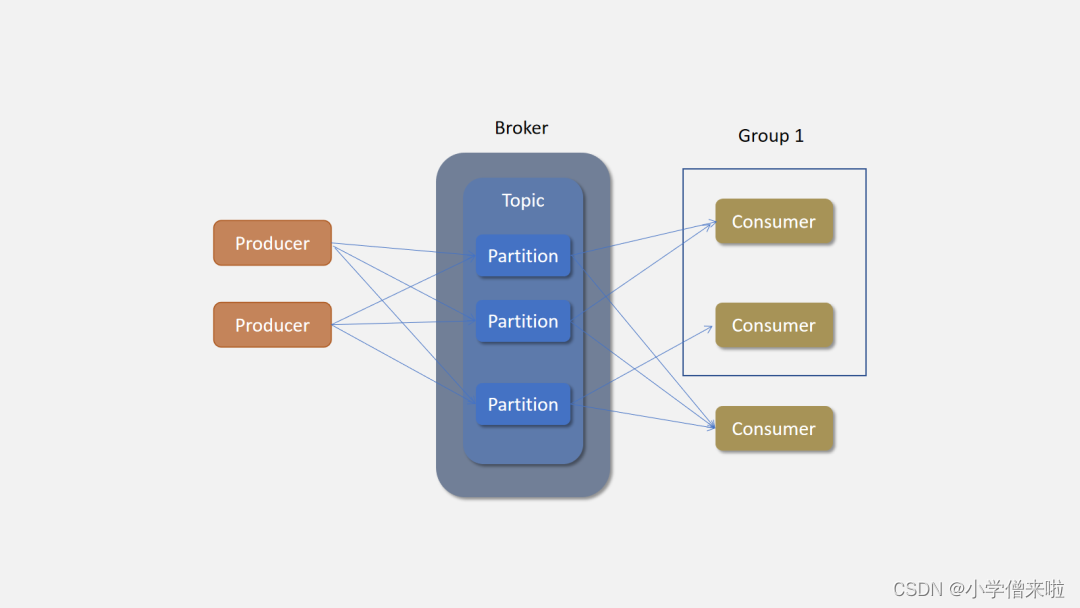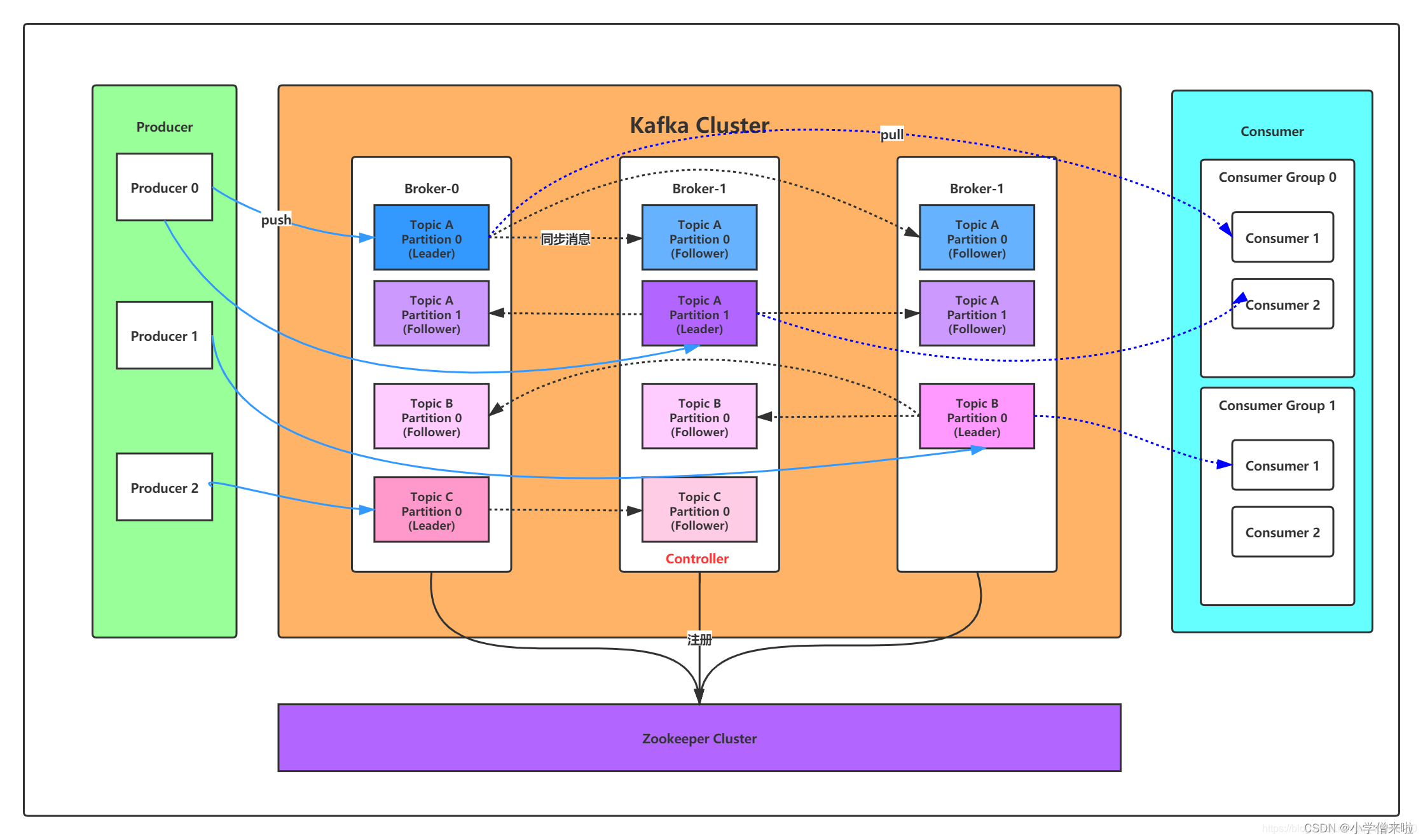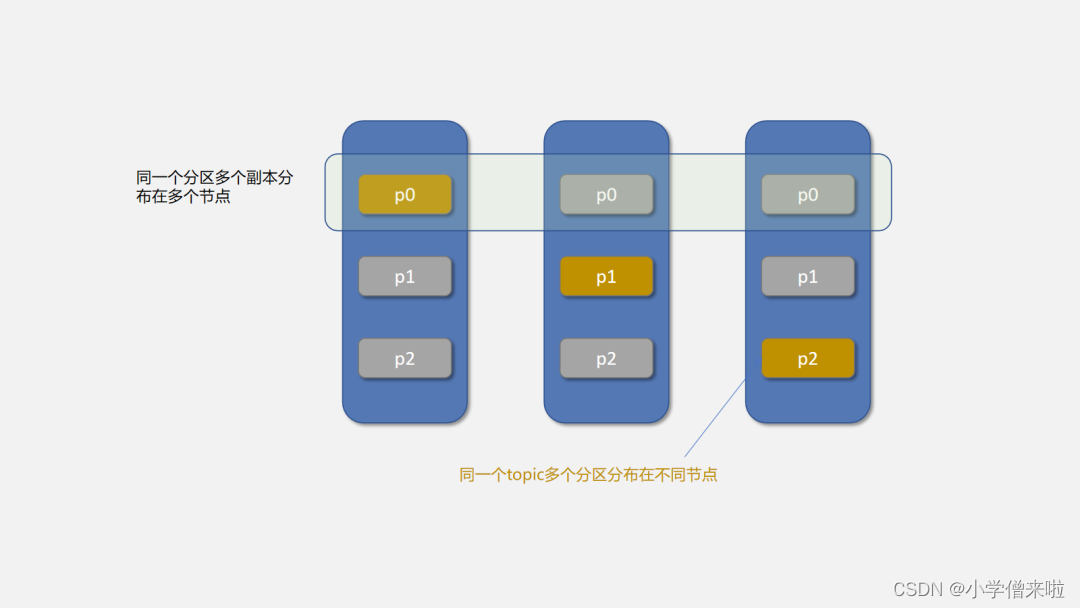@Author : Spinach | GHB
@Link : http://blog.csdn.net/bocai8058
Kafka简介
kafka是一种高吞吐量的分布式发布订阅消息系统,它可以处理消费者规模的网站中的所有动作流数据。这种动作(网页浏览,搜索和其他用户的行动)是在现代网络上的许多社会功能的一个关键因素。这些数据通常是由于吞吐量的要求而通过处理日志和日志聚合来解决。
Kafka基本概念
-
producer:生产者。Producer将消息发布到指定的Topic中,同时Producer也能决定将此消息归属于哪个partition;比如基于“round-robin”方式或者通过其他的一些算法等。
-
consumer:消费者。每个consumer属于一个consumer group;反过来说,每个group中可以有多个consumer。发送到Topic的消息,只会被订阅此Topic的每个group中的一个consumer消费。
1. 如果所有的consumer都具有相同的group,这种情况和queue模式很像;消息将会在consumers之间负载均衡。
2. 如果所有的consumer都具有不同的group,那这就是“发布-订阅”;消息将会广播给所有的消费者。
在kafka中,一个partition中的消息只会被group中的一个consumer消费,每个group中consumer消息消费互相独立;
但一个partition中的消息可以被不同group中一个consumer消费,而一个consumer可以消费多个partitions中的消息。
kafka只能保证一个partition中的消息被某个consumer消费时,消息是顺序的。
事实上,从Topic角度来说,消息仍不是有序的。
kafka的原理决定,对于一个topic,同一个group中不能有多于partitions个数的consumer同时消费,否则将意味着某些consumer将无法得到消息。
- topic:消息以topic为类别记录,Kafka将消息分门别类,每一类的消息称之为一个主题(Topic)。
一个Topic可以认为是一类消息,每个topic将被分成多个partition(区),每个partition在存储层面是append log文件。
任何发布到此partition的消息都会被直接追加到log文件的尾部,每条消息在文件中的位置称为offset(偏移量),offset为一个long型数字,它是唯一标记一条消息。
它唯一的标记一条消息。kafka并没有提供其他额外的索引机制来存储offset,因为在kafka中几乎不允许对消息进行“随机读写”。

- broker:以集群的方式运行,可以由一个或多个服务组成,每个服务叫做一个broker;消费者可以订阅一个或多个主题(topic),并从Broker拉数据,从而消费这些已发布的消息。每个消息(也叫作record记录,也被称为消息)是由一个key,一个value和时间戳构成。

Kafka架构
分布式(Distribution)
一个Topic的多个partitions,被分布在kafka集群中的多个server上;每个server(kafka实例)负责partitions中消息的读写操作;此外kafka还可以配置partitions需要备份的个数(replicas),每个partition将会被备份到多台机器上,以提高可用性。
基于replicated方案,那么就意味着需要对多个备份进行调度;
每个partition都有一个为“leader”;
leader负责所有的读写操作,如果leader失效,那么将会有其他follower来接管(成为新的leader);
follower只是单调的和leader跟进,同步消息即可。
由此可见作为leader的server承载了全部的请求压力
因此从集群的整体考虑,有多少个partitions就意味着有多少个“leader”,kafka会将“leader”均衡的分散在每个实例上,来确保整体的性能稳定。
Log的分区被分布到集群中的多个服务器上。每个服务器处理它分到的分区。根据配置每个分区还可以复制到其它服务器作为备份容错。
每个分区有一个leader,零或多个follower。Leader处理此分区的所有的读写请求,而follower被动的复制数据。
如果leader宕机,其它的一个follower会被推举为新的leader。一台服务器可能同时是一个分区的leader,另一个分区的follower。
这样可以平衡负载,避免所有的请求都只让一台或者某几台服务器处理。
kafka运行过程



Kafka配置
# Licensed to the Apache Software Foundation (ASF) under one or more
# contributor license agreements. See the NOTICE file distributed with
# this work for additional information regarding copyright ownership.
# The ASF licenses this file to You under the Apache License, Version 2.0
# (the "License"); you may not use this file except in compliance with
# the License. You may obtain a copy of the License at
#
# http://www.apache.org/licenses/LICENSE-2.0
#
# Unless required by applicable law or agreed to in writing, software
# distributed under the License is distributed on an "AS IS" BASIS,
# WITHOUT WARRANTIES OR CONDITIONS OF ANY KIND, either express or implied.
# See the License for the specific language governing permissions and
# limitations under the License.
# see kafka.server.KafkaConfig for additional details and defaults
############################# Server Basics #############################
# The id of the broker. This must be set to a unique integer for each broker.
broker.id=1
############################# Socket Server Settings #############################
# The address the socket server listens on. It will get the value returned from
# java.net.InetAddress.getCanonicalHostName() if not configured.
# FORMAT:
# listeners = listener_name://host_name:port
# EXAMPLE:
# listeners = PLAINTEXT://your.host.name:9092
#listeners=PLAINTEXT://:9092
# Hostname and port the broker will advertise to producers and consumers. If not set,
# it uses the value for "listeners" if configured. Otherwise, it will use the value
# returned from java.net.InetAddress.getCanonicalHostName().
#advertised.listeners=PLAINTEXT://your.host.name:9092
# Maps listener names to security protocols, the default is for them to be the same. See the config documentation for more details
#listener.security.protocol.map=PLAINTEXT:PLAINTEXT,SSL:SSL,SASL_PLAINTEXT:SASL_PLAINTEXT,SASL_SSL:SASL_SSL
# The number of threads that the server uses for receiving requests from the network and sending responses to the network
num.network.threads=3
# The number of threads that the server uses for processing requests, which may include disk I/O
num.io.threads=8
# The send buffer (SO_SNDBUF) used by the socket server
socket.send.buffer.bytes=102400
# The receive buffer (SO_RCVBUF) used by the socket server
socket.receive.buffer.bytes=102400
# The maximum size of a request that the socket server will accept (protection against OOM)
socket.request.max.bytes=104857600
############################# Log Basics #############################
# A comma seperated list of directories under which to store log files
log.dirs=/home/ghb/HadoopCluster/kafka_2.11-1.0.1/logs
# The default number of log partitions per topic. More partitions allow greater
# parallelism for consumption, but this will also result in more files across
# the brokers.
num.partitions=1
# The number of threads per data directory to be used for log recovery at startup and flushing at shutdown.
# This value is recommended to be increased for installations with data dirs located in RAID array.
num.recovery.threads.per.data.dir=1
############################# Internal Topic Settings #############################
# The replication factor for the group metadata internal topics "__consumer_offsets" and "__transaction_state"
# For anything other than development testing, a value greater than 1 is recommended for to ensure availability such as 3.
offsets.topic.replication.factor=1
transaction.state.log.replication.factor=1
transaction.state.log.min.isr=1
############################# Log Flush Policy #############################
# Messages are immediately written to the filesystem but by default we only fsync() to sync
# the OS cache lazily. The following configurations control the flush of data to disk.
# There are a few important trade-offs here:
# 1. Durability: Unflushed data may be lost if you are not using replication.
# 2. Latency: Very large flush intervals may lead to latency spikes when the flush does occur as there will be a lot of data to flush.
# 3. Throughput: The flush is generally the most expensive operation, and a small flush interval may lead to excessive seeks.
# The settings below allow one to configure the flush policy to flush data after a period of time or
# every N messages (or both). This can be done globally and overridden on a per-topic basis.
# The number of messages to accept before forcing a flush of data to disk
#log.flush.interval.messages=10000
# The maximum amount of time a message can sit in a log before we force a flush
#log.flush.interval.ms=1000
############################# Log Retention Policy #############################
# The following configurations control the disposal of log segments. The policy can
# be set to delete segments after a period of time, or after a given size has accumulated.
# A segment will be deleted whenever *either* of these criteria are met. Deletion always happens
# from the end of the log.
# The minimum age of a log file to be eligible for deletion due to age
log.retention.hours=1
# A size-based retention policy for logs. Segments are pruned from the log unless the remaining
# segments drop below log.retention.bytes. Functions independently of log.retention.hours.
#log.retention.bytes=1073741824
# The maximum size of a log segment file. When this size is reached a new log segment will be created.
#log.segment.bytes=1073741824
log.segment.bytes=10485760
# The interval at which log segments are checked to see if they can be deleted according
# to the retention policies
log.retention.check.interval.ms=300000
############################# Zookeeper #############################
# Zookeeper connection string (see zookeeper docs for details).
# This is a comma separated host:port pairs, each corresponding to a zk
# server. e.g. "127.0.0.1:3000,127.0.0.1:3001,127.0.0.1:3002".
# You can also append an optional chroot string to the urls to specify the
# root directory for all kafka znodes.
zookeeper.connect=127.0.0.1:2181,127.0.0.1:2182
port=6667
delete.topic.enable=true
# Timeout in ms for connecting to zookeeper
zookeeper.connection.timeout.ms=6000
############################# Group Coordinator Settings #############################
# The following configuration specifies the time, in milliseconds, that the group coordinator will delay the initial consumer rebalance.
# The rebalance will be further delayed by the value of group.initial.rebalance.delay.ms as new members join the group, up to a maximum of max.poll.interval.ms.
# The default value for this is 3 seconds.
# We override this to 0 here as it makes for a better out-of-the-box experience for development and testing.
# However, in production environments the default value of 3 seconds is more suitable as this will help to avoid unnecessarily, and potentially expensive rebalances during application startup.
group.initial.rebalance.delay.ms=0
Kafka应用场景
-
构建实时的流数据管道,可靠地获取系统和应用程序之间的数据。
-
构建实时流的应用程序,对数据流进行转换或反应。
1.Messaging
对于一些常规的消息系统,kafka是个不错的选择;
partitions/replication和容错,可以使kafka具有良好的扩展性和性能优势。
不过到目前为止,我们应该很清楚认识到,kafka并没有提供JMS中的“事务性”、“消息传输担保(消息确认机制)”、“消息分组”等企业级特性;
kafka只能使用作为“常规”的消息系统,在一定程度上,尚未确保消息的发送与接收绝对可靠(比如:消息重发,消息发送丢失等)。
2.Website activity tracking
kafka可以作为“网站活性跟踪”的最佳工具;
可以将网页/用户操作等信息发送到kafka中。
并实时监控,或者离线统计分析等。
3.Log Aggregation
kafka的特性决定它非常适合作为“日志收集中心”;
application可以将操作日志“批量”、“异步”的发送到kafka集群中,而不是保存在本地或者DB中;
kafka可以批量提交消息/压缩消息等,这对producer端而言,几乎感觉不到性能的开支。
此时consumer端可以使hadoop等其他系统化的存储和分析系统。
总结
-
Producer生产者发布数据尾部追加给topic(其中一个topic可以有多个partition,且同一个topic中的不同partition可以在不同的broker中,且每个partiotion被默认备份成3份,但一个partition只能被同一个consumer group中的一个consumer消费,同样一个partition可以被不同consumer group中一个consumer消费)的partition log中(每个partition是以log文件形式存在)。
-
Consumer消费者订阅topic中的消息。consumer端向broker发送“fetch”请求,并告知其获取消息的offset;此后consumer将会获得一定条数的消息;consumer端也可以重置offset来重新消费消息。

推荐:https://blog.csdn.net/vinfly_li/article/details/79397201






















 2106
2106











 被折叠的 条评论
为什么被折叠?
被折叠的 条评论
为什么被折叠?








